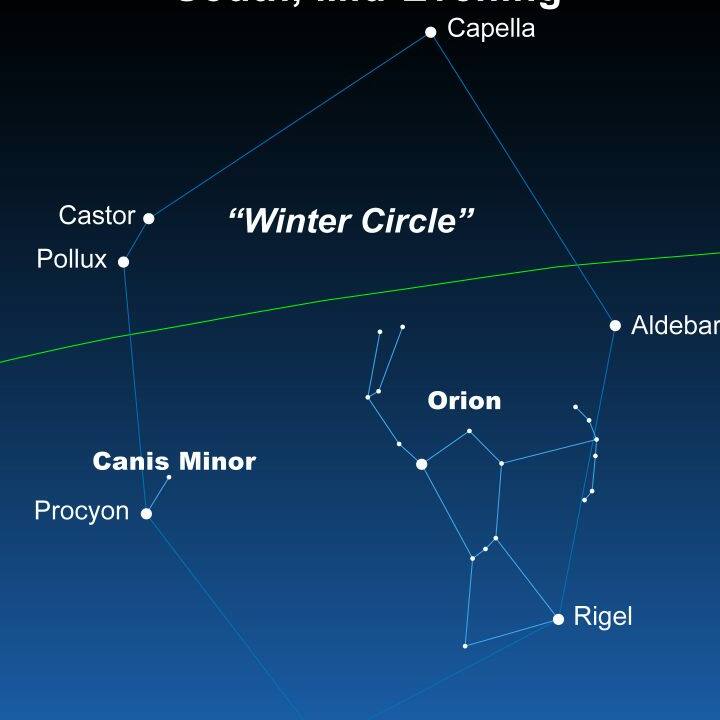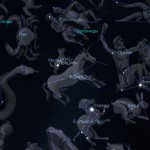
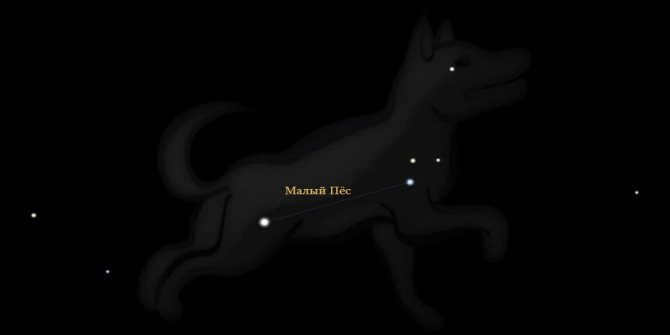
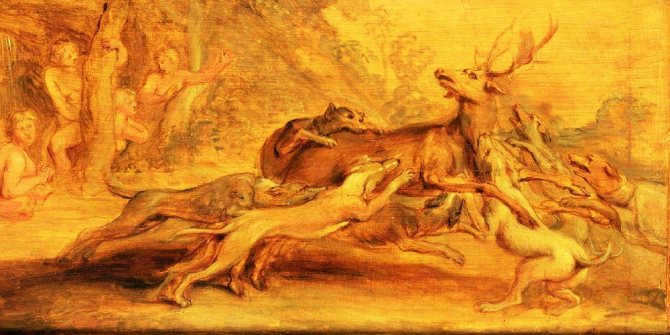
The equatorial diagram of the Canis Minor constellation can be found on the star map, showcasing its description, photos, bright stars including Procyon, interesting facts, celestial objects, and asterism.
Canis Minor is a constellation situated in the northern sky, with its Latin name translating to “small” or “little dog”.
It is one of the two dogs that accompanied Orion during his hunts, with the other being the larger Canis Major. Both constellations were originally documented by Ptolemy in the second century.
The constellation Canis Minor contains one of the most brilliant stars in the universe, Procyon. The nearest star to us is Leuthen’s Star. Also worth mentioning is the spiral galaxy NGC 2485.
Information, position, and map of the Canis Minor constellation
The Canis Minor constellation is ranked 71st in terms of brightness, covering an area of 183 square degrees. It is located in the second quadrant of the northern hemisphere (NQ2). It can be observed at latitudes ranging from +90° to -75°. Adjacent constellations include Cancer, Gemini, Hydra, and Unicorn.
- Procyon (α CMi) – 0.38m
- Gomeys (β CMi) – 2.89m
- Canis Minorides
- Unicorn
- Gemini
- Cancer
- Hydra
Little Dog constellation does not include any Messier objects or stars with planets. The brightest star in this constellation is Procyon, which is also the 7th brightest star overall. In addition, there is a meteor stream called Canis Minoridae, which is part of the Orion group along with Unicorn, Orion, Hare, and Big Dog. Take a look at the star map to see the diagram of the Little Dog constellation.
Mythology and historical background
Traditionally, it is believed that the object in question is one of the hounds that accompany Orion’s hunters in his conquests. However, there exists another equally fascinating tale. Legend has it that the small dog actually belonged to a vintner named Icarius, who was tragically killed by his own friends, who mistakenly thought he wanted to poison them.
Have you ever wondered: What is the distance between Mars and Jupiter?
The dog discovered its master’s lifeless body and sought out his daughter. The death of their patriarch was such a sorrowful event that they felt compelled to take their own lives. The dog leaped from a towering cliff, while the daughter chose to hang herself. Zeus, in his mercy, immortalized them in the stars. According to the myth, Icarius is connected to the constellation Bootes, and his daughter Erigon is represented as the constellation Virgo. The faithful dog itself became the constellation Canis Minor.
Afterwards, the king had no other choice but to begin beseeching the deity Zeus for deliverance. He dispatched gusts of wind which persisted for a span of 40 days. These winds continue to visit the island in a cyclical manner even in the present day. As a result, the clergy instituted the tradition of performing sacrifices each year prior to the ascension of Sirius.
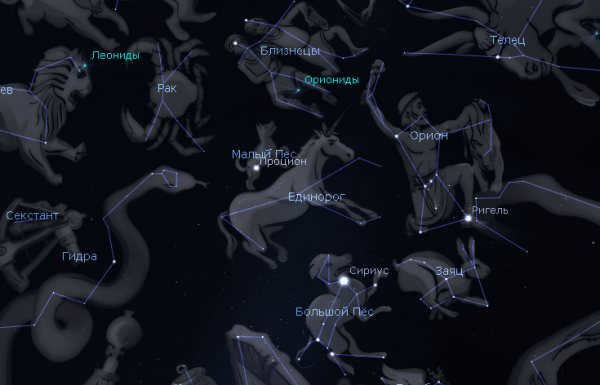
Little Pup
The fable regarding the constellation of the Small Dog
It is most commonly believed to be one of the hounds accompanying the hunter Orion. However, there is also a tale in which it was a canine named Mera, owned by the vintner Icarius, who was murdered by his comrades following a night of heavy drinking (he had initially treated them to wine, and they suspected he intended to poison them). The dog discovered his master’s lifeless body and went to his daughter Erigona. They were both so grief-stricken by the loss that they took their own lives. Erigona hanged herself, while the dog leaped from a precipice. Zeus elevated both of them to the heavens. Icarius is associated with the constellation Libra, Erigona with Virgo, and Mera with the constellation Canis Minor.
Hyginus, an ancient writer, retold the myth and made changes to the ending. According to his version, the murderers of Icarius escaped to Keos Island. As a punishment, the entire island was plagued by a devastating disease and famine, which Hyginus mistakenly attributed to the star Sirius (he actually confused it with Porcion). In desperation, the king turned to Zeus, praying for deliverance. In response, Zeus sent forth the Aetesian winds, which blew for a duration of 40 days and now repeat this cycle every year, providing a cooling effect on Greece during the summer. As a result, the priests established a tradition of performing annual ritual sacrifices until the rising of Sirius.
History of the Canis Minor Constellation
The Canis Minor constellation has a long and rich history. It can be traced back to ancient times and was included in Claudius Ptolemy’s Almagest catalog of the starry sky. In Ptolemy’s catalog, it was referred to as the main star of the constellation Procyon.
In ancient maps and mythology, the Canis Minor constellation is often associated with the hunter Orion. However, myths typically mention only one dog of Orion, which is represented by the Canis Major constellation. The Canis Minor constellation was named after one of Orion’s dogs, Actaeon, who tragically killed his master after being transformed into a deer by Artemis.
Another myth linked to the Canis Minor constellation involves the star Procyon. It was believed to be the dog of Icarius Mera, who discovered the lifeless body of his master after he was killed by drunken shepherds. This myth sometimes extended to the entire constellation.
The primary celestial bodies of the Small Dog constellation
Discover the brilliant celestial bodies within the constellation known as Little Dog, complete with comprehensive explanations, captivating imagery, and thorough characterizations.
Procyon (also known as Alpha Minor Dog) is an intriguing binary star system consisting of a luminous main-sequence star (Procyon A) of the F5 IV-V spectral class and Procyon B, a faint white dwarf of the DA type. Procyon A possesses a mass 1.4 times that of our Sun and radiates with a luminosity 7.5 times greater. In contrast, Procyon B has a mass of 0.6 solar masses and displays an apparent magnitude of 10.7.
Derived from the Greek word “προκύον,” which means “before the dog,” the term refers to the star that appears in front of Sirius (known as the Dog Star) when observed from most northern latitudes.
Procyon is a component of the Winter Triangle asterism, along with Sirius and Betelgeuse. Additionally, it forms one of the vertices of the Winter Hexagon, which includes Capella, Aldebaran, Castor, Pollux, Rigel, and Sirius.
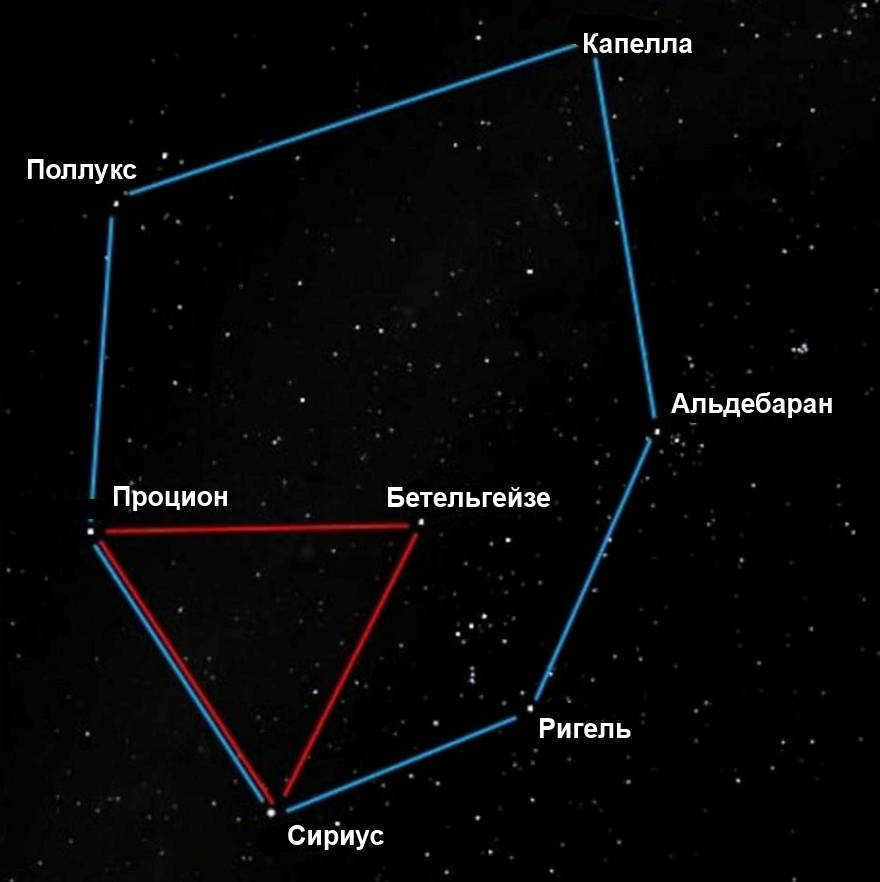
Stars of the Winter Triangle and Winter Hexagon
Beta Canis Minoris (also known as Gomeis) is the second most luminous star in the constellation Canis Minor. It is classified as a Gamma Cassiopeia variable and belongs to the hot main-sequence stars of type B8. Located approximately 170 light-years away, its average apparent magnitude is 2.89, with brightness varying between 2.84 and 2.92.
Beta Canis Minoris is known for its rapid rotation and irregular changes in luminosity, which are caused by the shedding of matter. This phenomenon gives the star its other name, shell star, as it is surrounded by a disk of ejected material that is heated by the ejections. The star’s name, Gomeis, is derived from the Arabic word “al-ghumaisa,” meaning “swarthy-eyed.”
Gamma Minor Dog – A binary star system located 398 light-years away from Earth with an apparent visual magnitude of 4.33. The primary star is an orange giant of K-type, while the companion star has an orbital period of 389 days.
G of the Little Dog – Another binary star system situated 261 light-years away. It consists of an orange giant star of K-type with a magnitude of 4.39.
Leuthen’s star (GJ 273) is a red dwarf located at a distance of 12.36 light-years and has an apparent magnitude of 9.87, making it quite challenging to observe. It is known to be the 22nd closest star system to our solar system. Its closest approach occurred approximately 13,000 years ago when it came within 3.67 parsecs. However, it is currently moving away from us gradually.
The star received its name in honor of Willem Jacob Leiten, a Dutch-American astronomer who first discovered its proper motion. Currently, it is situated 1.2 light-years away from the star Procyon.
Procyon, the brightest star in the constellation of Canis Minor
Procyon, known as one of the most luminous stars in the celestial sphere, holds the eighth place in terms of brightness. With a magnitude of 0.4m, Procyon shines brightly, making it unmistakable and distinct from other stars.
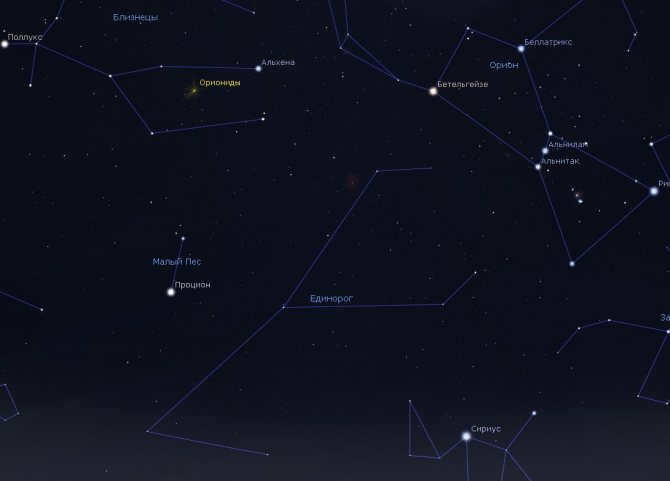
The constellation of the Lesser Dog can be found in the night sky.
The name of this star, Procyon, originates from Greek and means “before the dog.” This is because Procyon is positioned in the northern part of the sky, preceding Sirius, the alpha star of the Big Dog constellation. As a result, Procyon rises earlier and appears just before the Big Dog constellation.
Procyon is a fascinating star as it is one of the closest to Earth, only 11.4 light years away. Additionally, it is a binary system, consisting of two components. Component A is a hot white subgiant, while component B is a hot white dwarf.
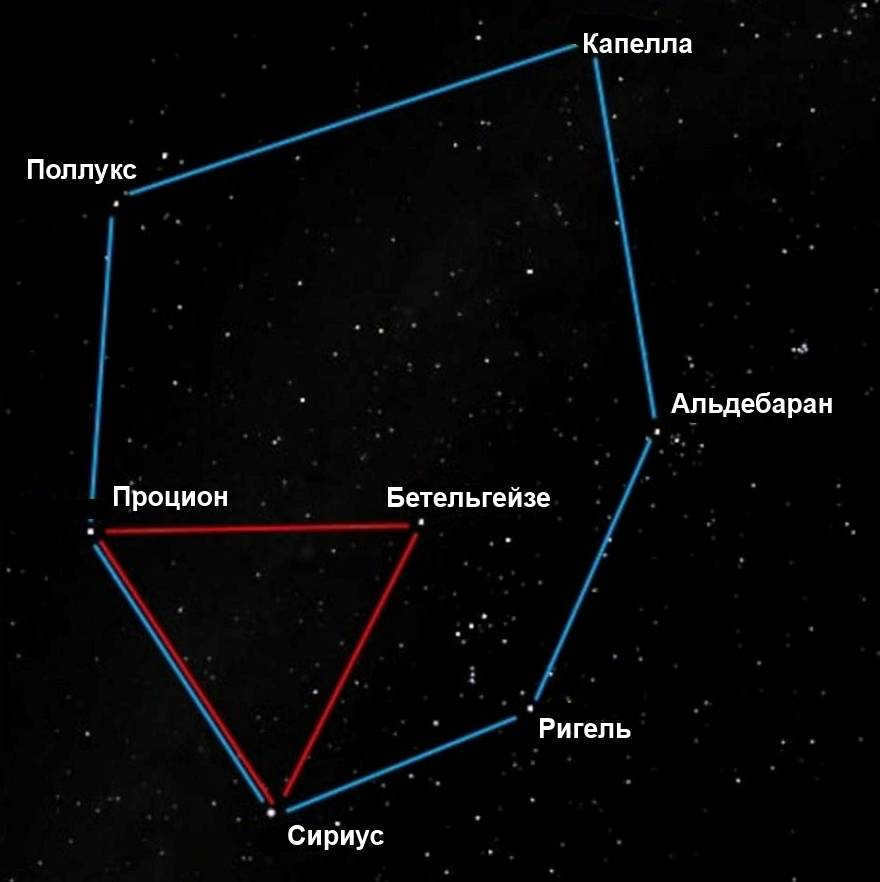
Winter Triangle and Winter Hexagon.
The Procyon system contains a large star that is similar in size to the Sun, but emits 7.5 times more light. This star is relatively young, less than 2 billion years old, and is currently expanding to become a giant. In the future, it will transform into a red giant, increasing its size to 80-150 times its current size.
Of particular interest in this system is Procyon’s white dwarf, known as component B. This white dwarf is similar to Puppy, a dwarf star in the Sirius system, but Procyon’s white dwarf is even denser. The distance between stars in the Procyon system is only 16 astronomical units, which is equivalent to the distance from the Sun to Uranus. Procyon B has a brightness of 10.7m and cannot be seen by amateur stargazers.
Background
The history of this ancient constellation dates back to the time of Claudius Ptolemy’s Almagest catalog. It was originally included in the catalog under the name of the main star of the Procyon constellation.
In ancient maps, there are references to both the Great and Little Dogs accompanying the hunter Orion. However, myths primarily focus on the Big Dog constellation, which was believed to represent the dog of Orion. One such myth revolves around Actaeon, one of Orion’s dogs, who tragically tore apart his master after he was transformed into a deer by Artemis. Additionally, Procyon was associated with the story of Icarius Mera, who discovered the body of his master killed by drunken shepherds. This myth was sometimes attributed to the entire constellation as well.
The Southern Hemisphere’s Celestial Canines: Big Dog and Little Dog
Discover the wonders of the night sky with our collection of articles on telescopes. In this edition, we focus on the fascinating constellations of Big Dog and Little Dog, which have captivated stargazers for centuries. While these constellations can only be fully observed in the southern latitudes, we invite you to join us on a celestial journey through the cosmos. Mark your calendars for January and February, when these constellations are at their brightest.
What makes these constellations fascinating? They are in the company of Orion, a renowned constellation named after the legendary Greek hunter. They encompass some of the most brilliant stars in the sky. Procyon (part of the Little Dog constellation) is the eighth brightest celestial object, consisting of a double star. Sirius (part of the Big Dog constellation) is the brightest star, visible from almost anywhere on Earth. You can easily find pictures of these constellations and their major stars on the Internet.
If you want to observe these constellations, we recommend using Newton reflectors or mirror-lens telescopes. We are more than happy to assist you in making your choice – feel free to call or email us!
Unauthorized usage of this material, in whole or in part, for public publication in any media or format is strictly prohibited. However, you are allowed to mention this article with an active link to www.4glaza.ru.
The manufacturer retains the right to modify the price, product range, and specifications, or discontinue the item without prior notice.
Primary celestial bodies
The asterism of the Canis Minor constellation contains several prominent stars that are visible to the naked eye.
Alpha (Procyon)
Alpha in the Small Dog constellation is a binary star system, consisting of Procyon A and B. Procyon A has a mass of 1.4 times that of the Sun and a luminosity approximately 7.5 times greater. Procyon B, on the other hand, has a mass of 0.6 times that of the Sun and has an apparent magnitude of 10.7.
Beta (Gomeisa).
This celestial body is characterized by its high temperature and is considered the second brightest star. It belongs to the category of Gamma Cassiopeia variables, which are known for their variability in brightness. Its distance from Earth is estimated to be around 170 light years. The average magnitude of this star is 2.89, with a brightness range of 2.84-2.92.
Gamma
Gamma, on the other hand, is classified as a spectroscopic double-type luminosity. It is located at a distance of approximately 398 light years from Earth and has a visual magnitude of 4.33 units.
A double luminosity is present in a distance of 261 light-years. This particular star is classified as an orange giant and has a magnitude measurement of 4.39 units.
Have you seen the remarkable event of Yuri Gagarin’s historic flight into space?
GJ 273
GJ 273 is characterized as a red-colored dwarf star, located at a distance of 12.36 light-years from Earth. It has an apparent magnitude of 9.87 units. Currently, scientists are observing its gradual movement away from us.
In addition to the Little Dog constellation, there are several other significant objects that hold great importance and value in the field of modern science.
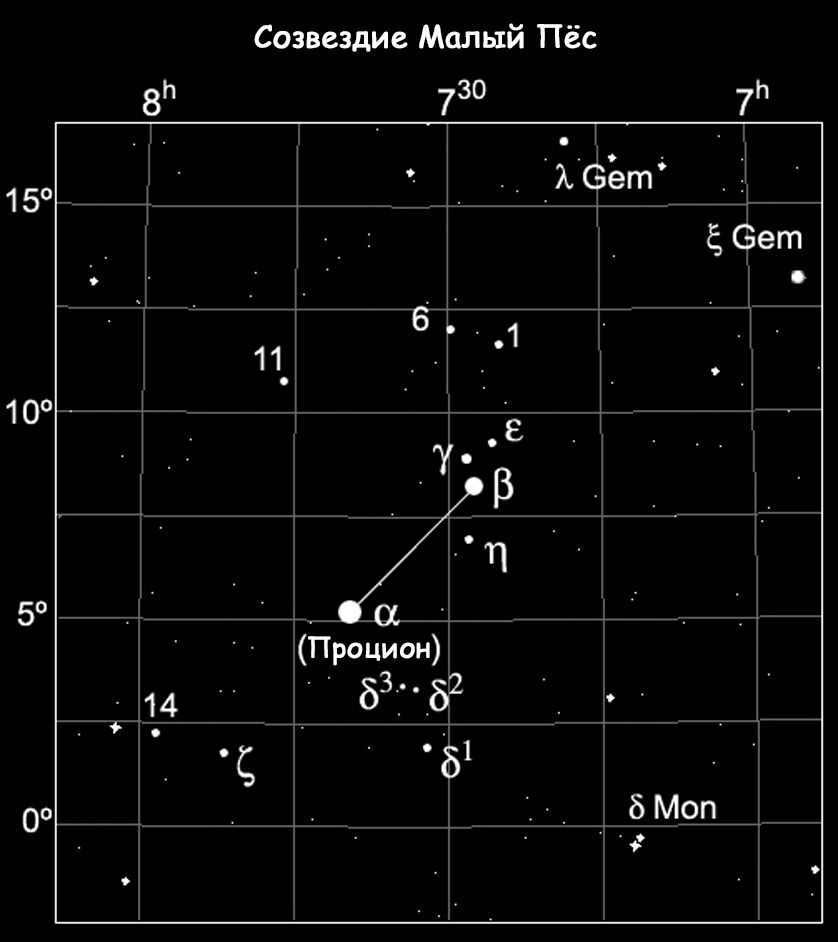
The constellation Small Dog is situated in the equatorial zone of the sky and is quite noticeable despite its small size.
Overview
The two most prominent stars in the Small Dog constellation are Alpha and Beta, with apparent magnitudes of 0.38 and 2.89, respectively. Along with these stars, there are 6 other stars brighter than the fourth magnitude, 20 stars brighter than the fifth magnitude, and 41 additional stars visible to the naked eye (with an apparent magnitude of less than 6.5m). No significant celestial objects brighter than 15th magnitude have been observed in the Little Dog constellation.
Where is it located?
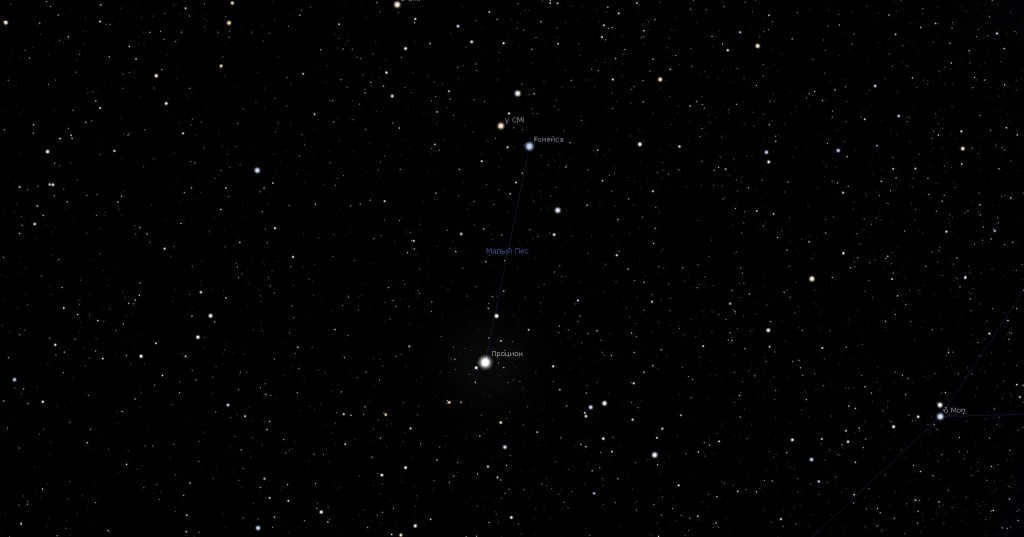

Photograph of the Small Dog constellation, visible in the Stellarium planetarium software
The neighboring constellations of Small Dog include Unicorn, Cancer, Gemini, and Hydra. It is easily identifiable due to the presence of Procyon, a highly luminous star that forms one of the vertices of a celestial pattern known as the Winter Triangle. In relation to the Milky Way, Small Dog is positioned symmetrically to Orion, providing an additional point of reference for observers. Although visible throughout the Northern Hemisphere, the constellation is best observed in southern regions. The months of January and February offer optimal conditions for amateur stargazers to study this constellation.
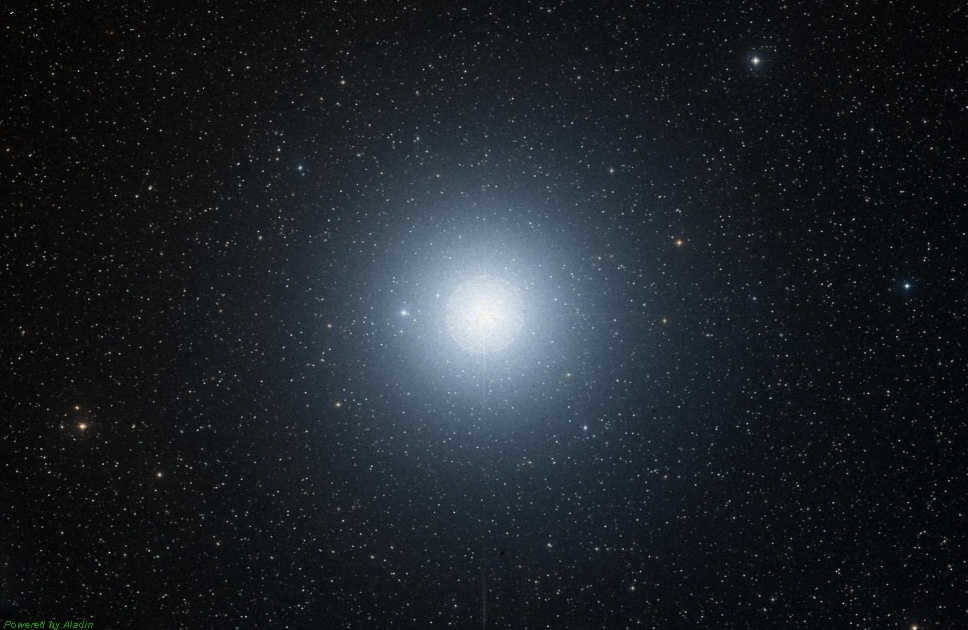
Image of Procyon or HIP 37279
Procyon, located approximately 11.41 light-years away, is one of the nearest stars to Earth. It shines 7.5 times brighter than our Sun. Similar to many celestial bodies, Procyon is a binary star system. The primary component is classified as a subgiant, while the secondary component is a white dwarf. Scientists speculate that in the next 10-100 million years, the primary star will expand by 80-150 times its current size, transitioning from its current yellow-white color to red or orange. This transformation mirrors what is predicted to happen to our own Sun.
Star Gomeisa
Discovering the Mysteries of Gomeisa
Gomeisa, also known as Beta Canis Minoris, is a star located in the constellation Canis Minor. It is a binary star system, consisting of a blue-white main sequence star and a red dwarf star. Gomeisa is approximately 170 light-years away from Earth and has a visual magnitude of 2.89.
Despite its relatively close proximity to Earth, Gomeisa remains a mysterious star. Scientists have been studying it for years, trying to unravel its secrets. One of the main puzzles is the exact nature of its binary system. The two stars are so close together that they orbit each other in just 6.2 days, making it difficult to observe them individually.
Another mystery surrounding Gomeisa is its variability. The star’s brightness fluctuates over time, but the reasons behind this variability are still uncertain. Some scientists believe it may be due to stellar activity, such as spots on the star’s surface or the presence of a circumstellar disk. Others suggest that the companion star may be causing the fluctuations through its gravitational influence.
Despite these mysteries, Gomeisa has provided valuable insights into stellar evolution. By studying binary star systems like Gomeisa, scientists can better understand the life cycles of stars and the processes that lead to their formation and eventual demise.
In conclusion, Gomeisa is a fascinating star that continues to captivate astronomers with its mysteries. By further exploring and studying this celestial object, scientists hope to uncover more about its nature and contribute to our understanding of the universe.
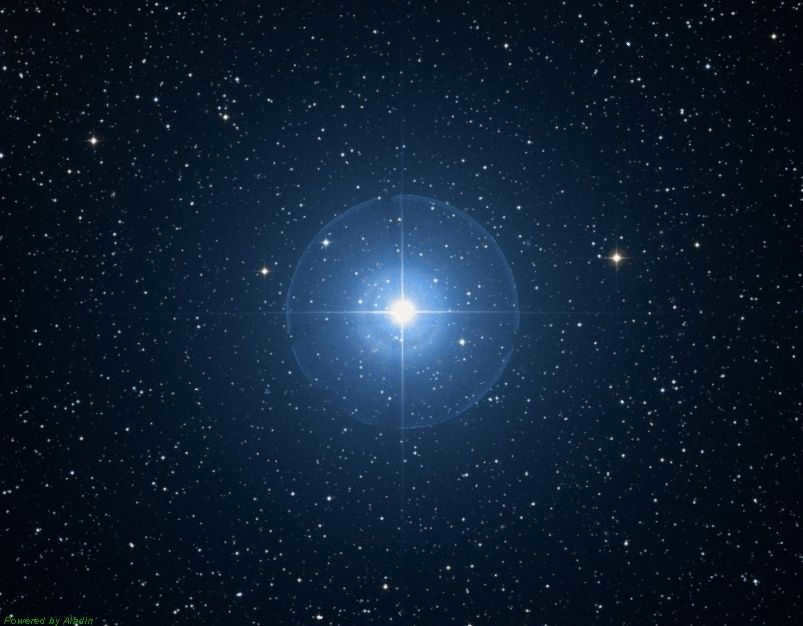
The Small Dog constellation’s Beta star has an Arabic-derived name. Gomeisa is a variable star with a remarkably high angular velocity. It is encompassed by a gas disk created through periodic bursts. This star is classified as a type of variable luminary. It is three times larger and four times heavier than the Sun, respectively. Its surface temperature is 11,500 K, and the star is located 170 light-years away. Gomeisa shines about 250 times brighter than the Sun.
The constellation’s history
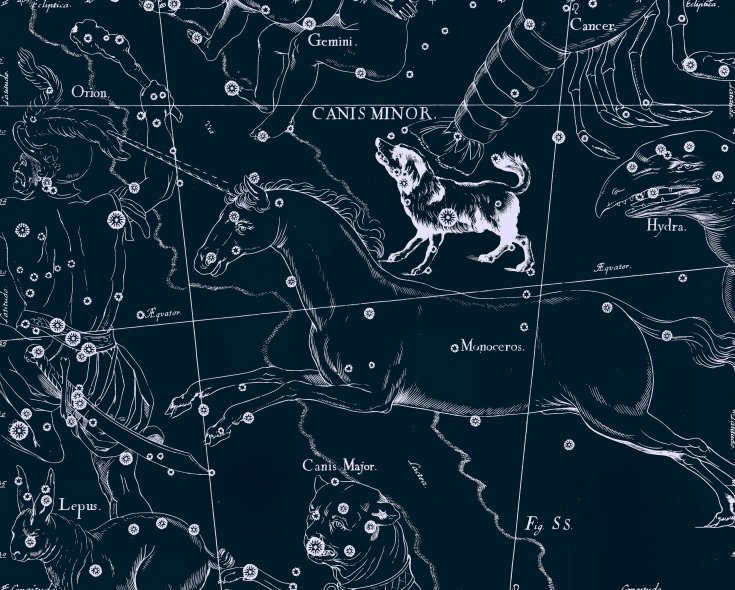

A depiction of a Small Dog, drawn by Jan Hevelius for his collection of constellations
This particular celestial formation has been documented since ancient times. It was even included in the Almagest, a significant astronomical publication by Claudius Ptolemy. However, its existence was known to people long before that. It is believed that the ancient Egyptian priests used the star Procyon as an indicator for the rising of Sirius. On ancient maps, this constellation was illustrated as the smaller one of the two canines chasing the Pleiades alongside the constellation Orion.
Nevertheless, the exact mythological character that inspired the creation of the Little Dog constellation remains a subject of debate among modern scientists.

The constellation known as the Small Dog is located in the celestial regions near the equator. It occupies an area of 183 square degrees, placing it at the 71st position among all constellations. It shares its boundaries with the constellations of Gemini, Hydra, Unicorn, and Cancer.
Despite its relatively small size, the Small Dog constellation is visually striking and stands out against the backdrop of the night sky. It is interesting to note that this constellation has been known to humanity since ancient times and was included in Ptolemy’s catalog. It was originally named Procyon, which is also the name of its brightest star.
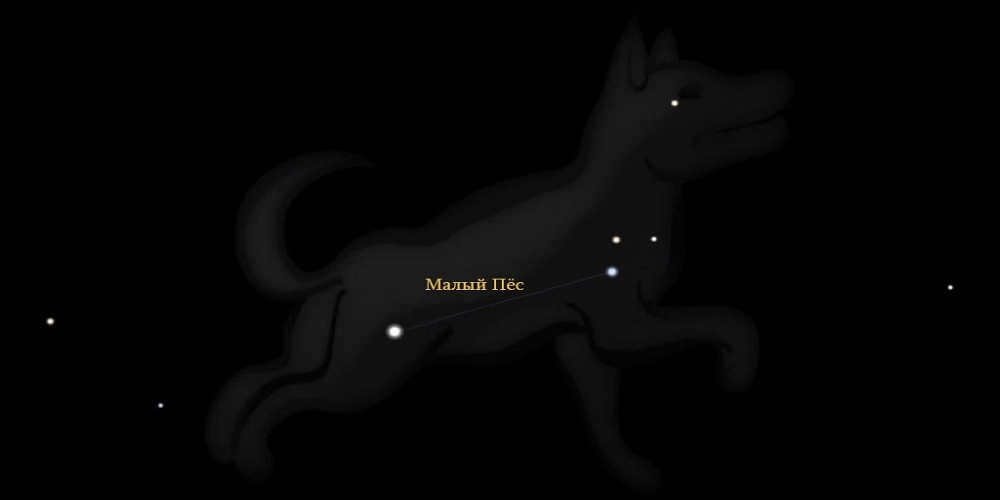
Additionally, the constellation known as Small Dog is often linked to the mythology surrounding Orion’s faithful companion. However, it is important to note that this connection has no direct relation to the heroic hunter.
Interestingly, there are two separate legends that offer explanations for the origins of this celestial grouping. Firstly, the Small Dog constellation is said to be a representation of the Mayor’s dog, which was owned by Icarius. Tragically, after the dog’s master was killed, the winemaker’s daughter and the dog both took their own lives. As a result, Zeus immortalized their memory by placing them in the night sky.
Secondly, Actaeon’s dog is also associated with this constellation. In this tale, Actaeon was transformed into a deer by Artemis, and his dogs, unaware of the transformation, attacked and tore apart their former master’s body.
There were, without a doubt, some peculiar tales circulating about the constellation Little Canine. Nonetheless, the region itself holds a great deal of fascination.
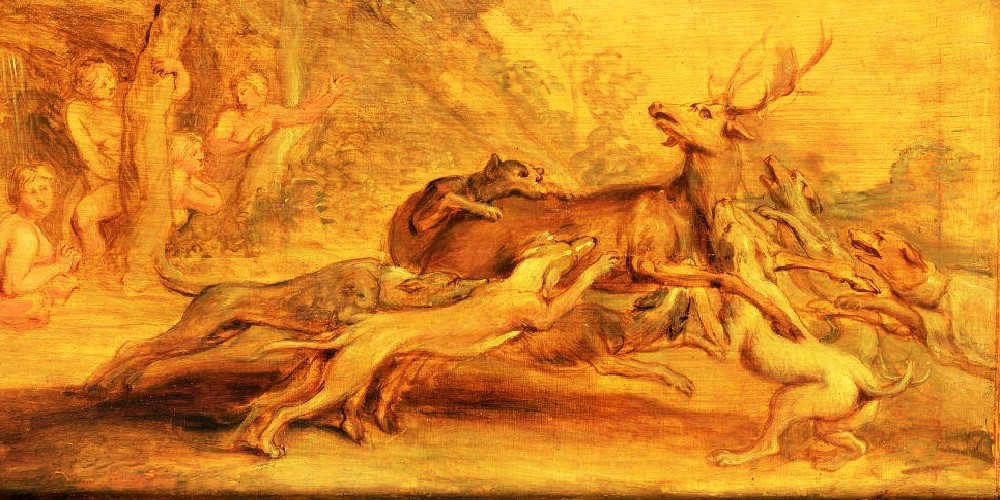
The stars that make up the Small Dog constellation
The brightest star in this area is Procyon – Alpha. It is a double system consisting of a main-sequence star and a dwarf. With an apparent magnitude of 0.34, it is the eighth brightest star in the entire sky and the 13th closest to us. Procyon’s name means “in front of the dog,” indicating its visual location just above Sirius.
In second place is Beta with a brightness of 2.89. It is also known as Gomeisa, which translates to “weeping eyes.” This star is a blue-colored subgiant and is variable. It is part of the Gamma Cassiopeia.
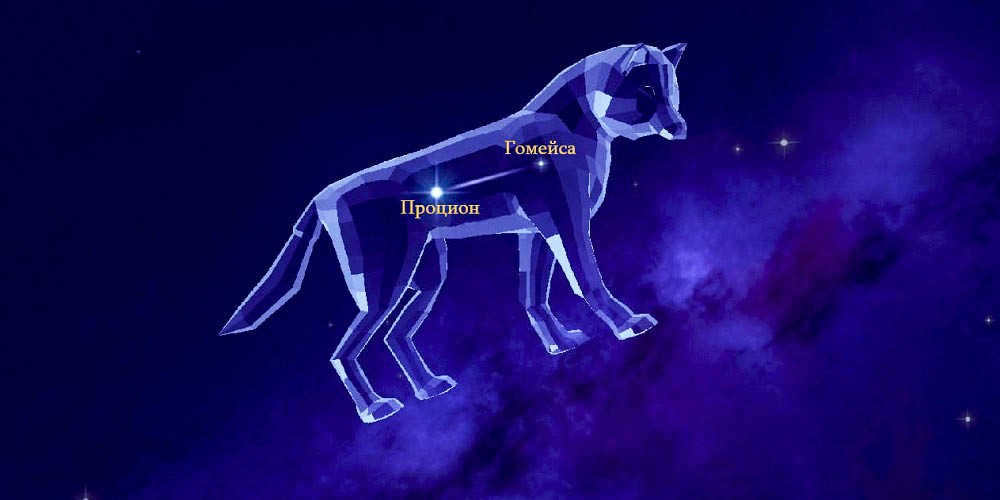
And here is Gamma Little Dog, a double luminosity star with a visual magnitude of 4.33.
G Little Dog is categorized as a double star with an orange giant as its primary component. It possesses a visual magnitude of 4.39.
Epsilon is a yellow giant star with a luminosity of 4.99.
The star Leuthena is a red dwarf. With a visual magnitude of 9.87, it could be considered a rather dim object. Nonetheless, it is one of the nearest stellar representatives to our solar system.
What are the objects found in the constellation Canis Minor?
Contrary to expectations, the constellation does not boast any remarkable objects. While it does contain various associations, they are quite faint and challenging to observe.
However, one notable object is the spiral galaxy NGC 2485, which stands out as the most visible (with a visual magnitude of 12.4).
Additionally, the constellation features the Canis Minoridae meteor shower.
It is worth mentioning that the prominent star Procyon is part of the well-known asterism known as the Winter Triangle. Furthermore, within the asterism, the Winter Hexagon serves as the upper point.
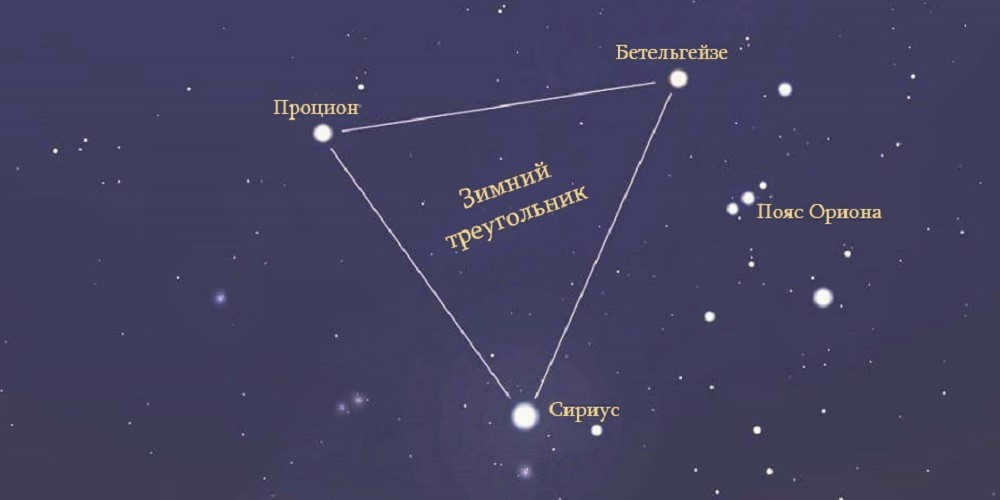
Observation
The Winter Triangle can be easily observed in latitudes ranging from +90 to -76 degrees, making it accessible to residents of southern Russia. However, it is visible throughout the entire territory of Russia, with the best viewing conditions occurring during the winter months of January and February.
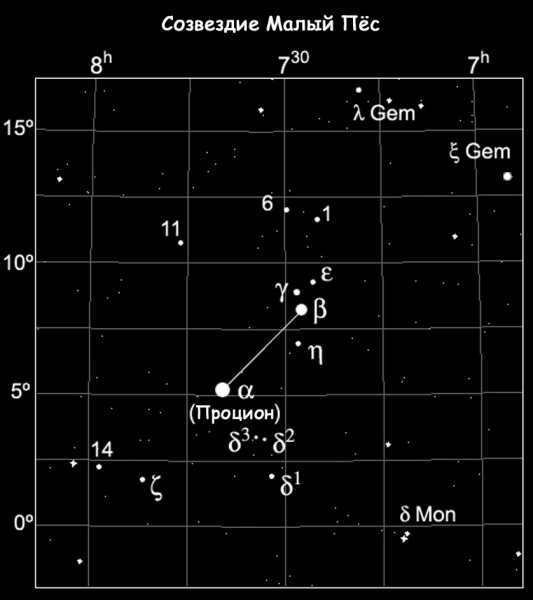
Located in the equatorial region of the celestial sphere is a diminutive yet observable constellation known as Small Dog.
Overview
The first two stars, Alpha and Beta, within the Small Dog constellation possess apparent magnitudes of 0.38 and 2.89, respectively. These two celestial bodies are the most prominent features within this specific area of the night sky. Furthermore, the Small Dog constellation encompasses an additional 6 stars that are brighter than the fourth apparent magnitude, 20 stars that are brighter than the fifth apparent magnitude, and 41 other stars that can be seen with the naked eye (less than 6.5m). Notably, no significant remote objects that are brighter than the 15th magnitude have been documented within the Little Dog constellation.
Place
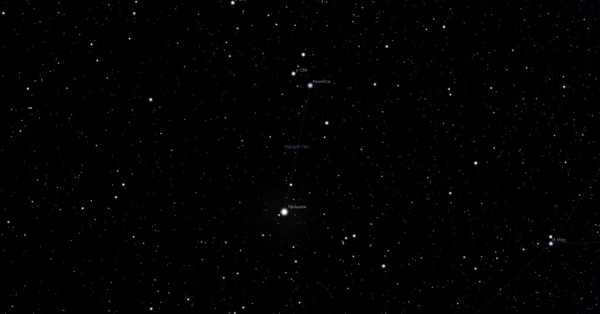
Check out the Small Dog constellation using the Stellarium planetarium program.
The closest neighbors of the Little Dog are the Unicorn, Cancer, Gemini, and Hydra constellations. One easy way to locate it is by finding Procyon, a very bright star that is one of the points of the Winter Triangle asterism. The Small Dog is positioned symmetrically to Orion with respect to the Milky Way, which can serve as another reference point. While visible throughout the Northern Hemisphere, it is best observed in the southern regions. The ideal months for amateur stargazers to explore this constellation are January and February.
Procyon Star
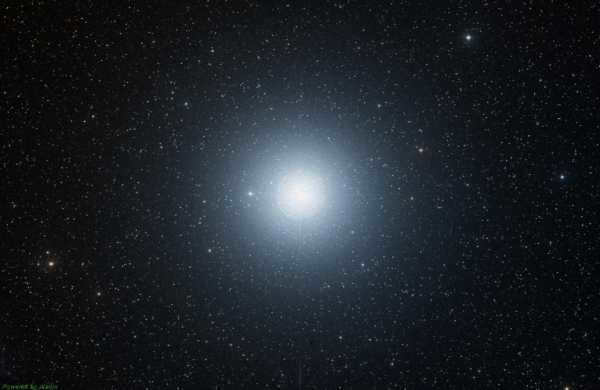
Procyon, also known as HIP 37279, is situated in the constellation Canis Minor and is one of the nearest stars to our planet, located just 11.41 light-years away. With a brightness approximately 7.5 times greater than that of the Sun, Procyon is a prominent celestial object. Interestingly, it is classified as a binary star system, consisting of two components: a subgiant star and a white dwarf. Scientists speculate that in the future, the main star of Procyon will experience significant expansion, increasing in size by 80-150 times, and transitioning from its current yellow-white hue to a vibrant red or orange color. Remarkably, this fate parallels the projected destiny of our own Sun, as predicted by experts in the field.
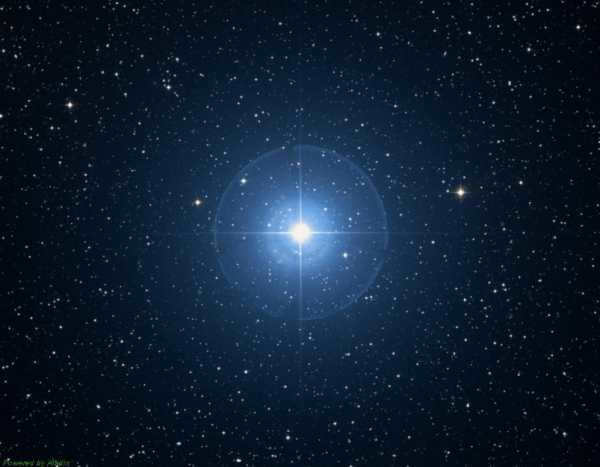
The Beta constellation received its name from the Arabic language. Gomeisa is a luminary that varies in brightness and has a remarkably fast speed of rotation. It is encompassed by a disk composed of gas that is formed by regular bursts of energy. This particular star is classified as a variable luminosity star. In terms of size and mass, it is three to four times larger and heavier than the Sun. The surface temperature of Gomeisa measures 11,500 K, and its distance from Earth is approximately 170 light-years. Gomeisa shines about 250 times brighter than our Sun.
The constellation’s historical background
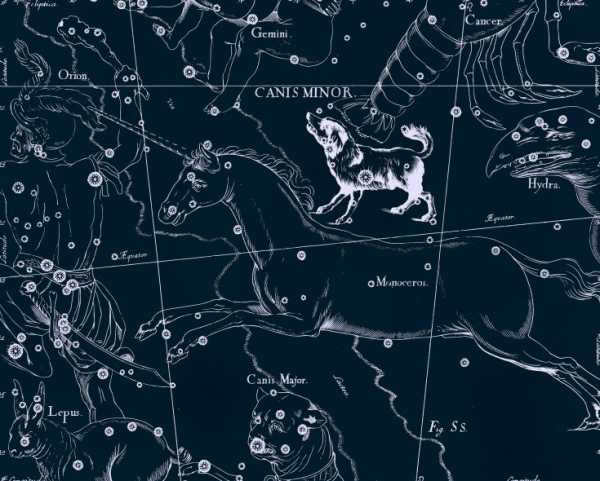

An illustration by Jan Hevelius, featuring a small dog, is found in his atlas of constellations.
This particular constellation, also known as Canis Minor, has been recognized since ancient times. It was documented in the Almagest, a significant astronomical work by Claudius Ptolemy. However, the roots of this constellation trace back even further in history, as Egyptian priests used Procyon as an indicator for the rising of Sirius. On ancient maps, this constellation was depicted as one of two dogs chasing the Pleiades alongside Orion. Nevertheless, historians remain divided on the precise mythological figure that served as its inspiration.

